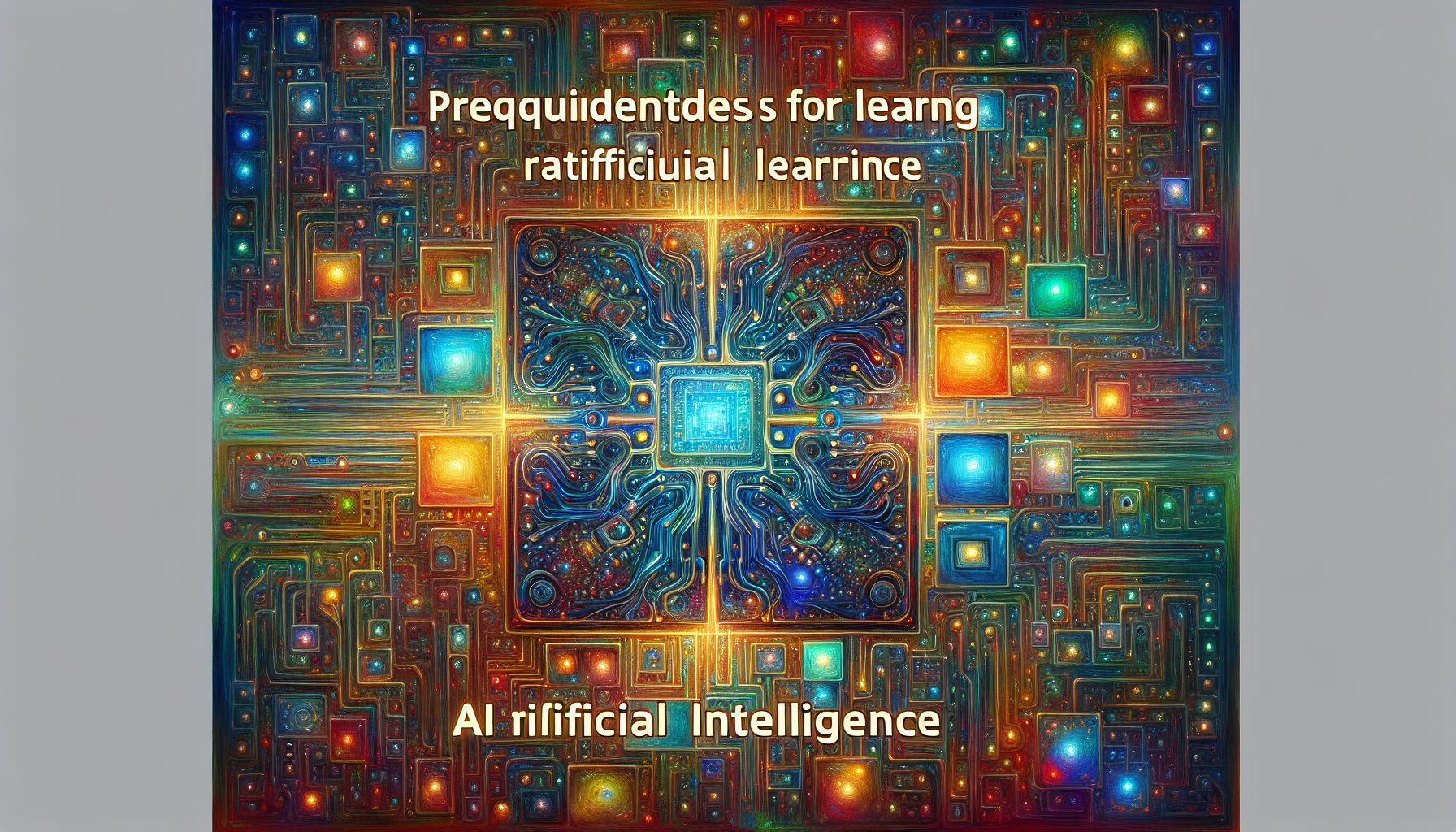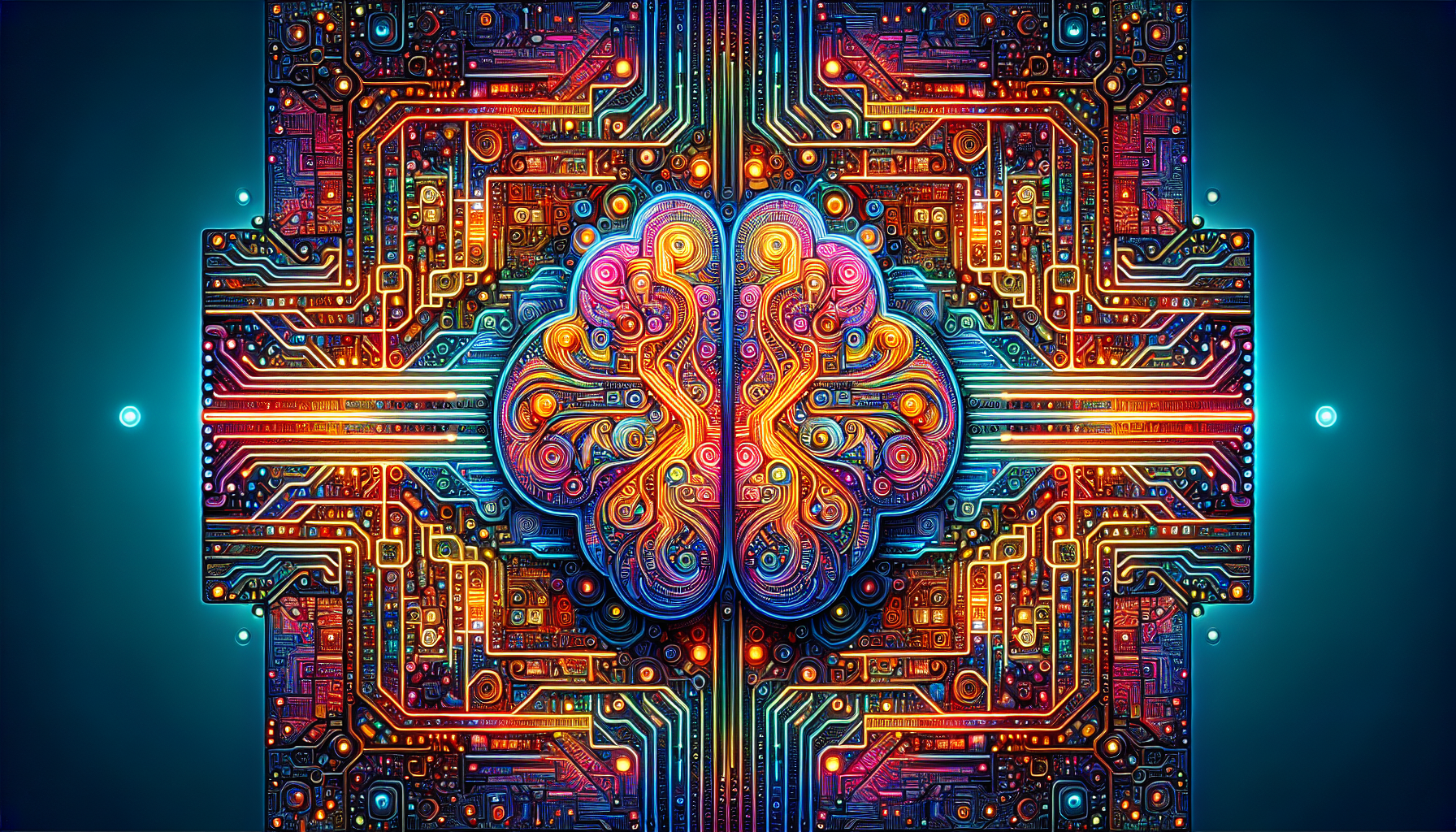Are you curious about diving into the world of AI but unsure if you have the necessary background? Well, fear not! This article aims to quell your worries by exploring the question of whether there are any prerequisites for learning AI. Whether you come from a technical or non-technical background, we will discuss the skills and knowledge that can be helpful in your AI journey. So, let’s embark on this exciting exploration together!
Understanding the Basics
Mathematics
Mathematics forms the foundation of AI and is an essential prerequisite for understanding and implementing AI algorithms. A strong grasp of mathematical concepts such as calculus, linear algebra, and probability theory is invaluable in analyzing and modeling complex AI systems. Calculus helps in understanding optimization algorithms, while linear algebra enables the manipulation of vectors and matrices, which are crucial in AI algorithms. Probability theory is necessary for modeling uncertainty and making predictions.
Statistics
Statistics plays a crucial role in AI as it deals with the collection, analysis, and interpretation of data. Understanding statistical concepts such as probability distributions, statistical inference, and hypothesis testing is vital for working with data and making informed decisions. It provides the tools required to draw meaningful insights from data, identify patterns, and make predictions.
Computer Science
Computer science is the backbone of AI, providing the fundamental principles and techniques for designing AI systems. It encompasses a wide range of topics, including algorithms, data structures, programming languages, and computer architecture. Knowledge of computer science allows you to implement AI algorithms efficiently, optimize computational performance, and understand the limitations and trade-offs involved in different approaches.
Programming Skills
Python
Python is one of the most popular programming languages for AI and machine learning. Its simplicity, readability, and vast ecosystem of libraries make it a great choice for beginners and experts alike. Python provides powerful libraries such as NumPy, Pandas, and Scikit-learn, which offer extensive support for data manipulation, analysis, and machine learning tasks.
Java
Java is a versatile programming language widely used in a variety of domains, including AI. It provides a robust and platform-independent environment for developing AI applications. Though Java may have a steeper learning curve compared to Python, it offers strong performance, scalability, and extensive libraries like Weka for machine learning and data mining tasks.
C++
C++ is a high-performance language that finds its applications in AI, especially when efficiency is a priority. It provides low-level control and allows programmers to optimize their code for performance-critical AI tasks. C++-based libraries like TensorFlow and OpenCV are widely used in AI research and development.
R
R is a programming language specifically designed for statistical computing and graphics. It is heavily used in data analysis, machine learning, and visualization. R provides numerous libraries like ggplot2 and caret, making it a popular choice among statisticians and researchers working on AI projects involving data analysis and visualization.

Machine Learning Fundamentals
Supervised Learning
Supervised learning is a machine learning technique in which a model is trained on labeled data to predict future outcomes. It involves mapping input variables to an output variable based on example input-output pairs. Supervised learning algorithms, such as linear regression, logistic regression, and support vector machines, learn from labeled datasets to make predictions, classify data, and solve regression problems.
Unsupervised Learning
Unsupervised learning is a machine learning technique that deals with unlabeled data. It aims to find patterns, relationships, and structures in the data without explicit guidance or supervision. Clustering algorithms like K-means and hierarchical clustering, as well as dimensionality reduction techniques like principal component analysis (PCA) and t-SNE, are commonly used in unsupervised learning to gain insights into data and discover hidden patterns.
Reinforcement Learning
Reinforcement learning is a type of machine learning that focuses on training agents to take actions in an environment to maximize their cumulative reward. It involves an agent learning from its interactions with the environment and receiving feedback in the form of rewards or penalties. Algorithms like Q-learning and Deep Q Networks are used to train agents to make decisions and learn optimal policies in complex environments.
Data Handling and Manipulation
Data Collection
Data collection is a crucial step in any AI project. It involves gathering relevant data from various sources, such as databases, APIs, or scraping data from websites. Understanding data collection methods, techniques, and tools is essential for obtaining high-quality and representative data for training and evaluating AI models.
Data Preprocessing
Data preprocessing is the process of cleaning, transforming, and preparing data for analysis. It involves tasks such as removing duplicates, handling missing values, normalizing data, and encoding categorical variables. Data preprocessing is crucial to ensure the quality and reliability of the data used in AI models.
Data Cleaning
Data cleaning involves identifying and handling errors, outliers, and inconsistencies within the collected data. It includes tasks like removing noise, correcting errors, and detecting and handling outliers. Data cleaning ensures that the data used for training AI models is accurate and reliable, leading to more robust and accurate predictions.
Feature Engineering
Feature engineering is the process of creating new features or transforming existing ones to better represent the underlying problem or improve the performance of AI models. It involves selecting relevant features, creating interaction terms, scaling features, and encoding categorical variables. Feature engineering plays a vital role in enhancing the predictive power of AI models and extracting meaningful information from the data.

Data Analysis and Visualization
Exploratory Data Analysis
Exploratory Data Analysis (EDA) is an essential step in understanding the characteristics and relationships within a dataset. It involves analyzing and summarizing data using statistical methods, visualization techniques, and descriptive statistics. EDA helps in identifying patterns, trends, and potential outliers, and guides the selection of appropriate machine learning algorithms and preprocessing steps.
Data Visualization
Data visualization is the process of representing data graphically to aid understanding and communication. It involves creating charts, graphs, and visual representations of data to highlight patterns, relationships, and trends. Data visualization helps in conveying complex information effectively and is valuable for presenting findings and insights from AI models to non-technical stakeholders.
Statistical Analysis
Statistical analysis involves using statistical methods and techniques to analyze and interpret data. It includes tasks such as hypothesis testing, correlation analysis, and regression analysis. Statistical analysis helps in uncovering relationships, making predictions, and drawing conclusions from data, enabling evidence-based decision-making in AI projects.
Algorithms and Libraries
Linear Regression
Linear regression is a simple yet powerful statistical technique for predicting a continuous outcome variable based on one or more input variables. It estimates the relationship between the dependent variable and independent variables by fitting a linear equation to the observed data. Linear regression is used for tasks like predicting housing prices based on features such as area, number of rooms, and location.
Logistic Regression
Logistic regression is a classification algorithm used to predict the probability of a binary or categorical outcome by modeling the relationship between the independent variables and the probability of the outcome. Logistic regression is commonly used in various applications, such as fraud detection, spam filtering, and disease diagnosis.
Decision Trees
Decision trees are versatile and interpretable machine learning models used for both classification and regression tasks. They partition the feature space into regions based on simple decision rules, enabling the model to learn complex relationships. Decision trees are widely used in areas like customer segmentation, credit scoring, and recommendation systems.
Random Forests
Random forests are an ensemble learning technique that combines multiple decision trees to make predictions. They reduce the risk of overfitting and improve prediction accuracy by aggregating the predictions of individual trees. Random forests are used in diverse applications, such as predicting stock market trends, analyzing customer churn, and object recognition in images.
Support Vector Machines
Support Vector Machines (SVM) are powerful supervised learning algorithms used for both classification and regression tasks. They find the optimal hyperplane that maximally separates different classes or predicts a continuous outcome. SVMs are widely used in tasks like sentiment analysis, text classification, and image recognition.
Neural Networks
Neural networks are complex mathematical models inspired by the structure and functionalities of the human brain. They consist of interconnected layers of artificial neurons and are capable of learning and recognizing patterns in data. Neural networks have seen tremendous success in image recognition, natural language processing, and speech recognition.
Deep Learning
Deep learning is a subfield of machine learning that focuses on building and training deep neural networks with multiple layers. Deep learning models excel at learning hierarchical representations of data and have achieved remarkable breakthroughs in areas like computer vision, natural language processing, and autonomous driving.
Natural Language Processing
Natural Language Processing (NLP) is a branch of AI that deals with the interaction between computers and human language. NLP algorithms enable computers to understand, interpret, and generate human language, allowing tasks like sentiment analysis, machine translation, and question-answering systems.
Recommender Systems
Recommender systems are algorithms that personalize recommendations for users based on their preferences, historical data, and behavioral patterns. They are widely used in e-commerce, streaming platforms, and content recommendation systems to improve user experience and increase engagement.
Genetic Algorithms
Genetic algorithms are inspired by the principles of natural selection and genetics and are optimization algorithms used to find optimal solutions to complex problems. They are particularly useful in domains where traditional optimization techniques struggle, such as feature selection, parameter tuning, and scheduling problems.

Understanding AI Models and Techniques
Supervised Learning Models
Supervised learning models are trained using labeled data to predict future outcomes or classify new data into predefined categories. Examples include linear regression, logistic regression, decision trees, and neural networks. Understanding the strengths, weaknesses, and assumptions of different supervised learning models is crucial for selecting the most appropriate approach for a given problem.
Unsupervised Learning Models
Unsupervised learning models are used to explore unlabeled data and discover hidden patterns, relationships, or groups. Examples include clustering algorithms like K-means and hierarchical clustering, and dimensionality reduction techniques like PCA and t-SNE. Unsupervised learning models are essential for tasks like customer segmentation, anomaly detection, and pattern recognition.
Reinforcement Learning Techniques
Reinforcement learning techniques focus on training agents to make decisions and learn optimal policies through interactions with an environment. Techniques like Q-learning, policy gradients, and Monte Carlo methods enable agents to learn from rewards and penalties, and improve their decision-making abilities over time. Reinforcement learning has applications in robotics, game playing, and autonomous systems.
Neural Networks Architectures
Neural network architectures define the structure and connections between artificial neurons in a neural network. Architectures like feedforward neural networks, convolutional neural networks (CNN), and recurrent neural networks (RNN) are tailored for specific types of data and tasks. Understanding different neural network architectures is essential for designing and fine-tuning models for specific problems.
Deep Learning Architectures
Deep learning architectures refer to neural network models with multiple layers, enabling them to extract hierarchical representations of data. Deep learning architectures like deep neural networks (DNNs), convolutional neural networks (CNNs), and recurrent neural networks (RNNs) have revolutionized AI applications in computer vision, natural language processing, and speech recognition.
Data Structures and Algorithms
Arrays
Arrays are fundamental data structures used to store and manipulate a collection of values of the same type. They provide efficient random access and are widely used in various algorithms and data manipulation tasks.
Linked Lists
Linked lists are dynamic data structures in which each element (node) contains a value and a reference to the next node. Linked lists allow efficient insertion and deletion of elements, making them useful in scenarios where the size of the data is unknown or changes frequently.
Stacks and Queues
Stacks and queues are abstract data types that allow adding and removing elements in a specific order. Stacks follow the Last-In-First-Out (LIFO) principle, while queues adhere to the First-In-First-Out (FIFO) principle. They are used in algorithms like depth-first search, breadth-first search, and memory management.
Trees
Trees are hierarchical data structures consisting of nodes connected by edges. They provide a way to organize and represent hierarchical relationships between elements. Trees are used in various algorithms and data structures, such as binary search trees, AVL trees, and decision trees.
Graphs
Graphs are versatile data structures that represent a set of vertices (nodes) connected by edges. They are used to model complex relationships and dependencies between objects. Graph algorithms like Dijkstra’s algorithm and depth-first search are essential for solving problems in areas like network analysis, social network analysis, and route planning.
Sorting Algorithms
Sorting algorithms arrange elements in a specific order, typically based on their values. Popular sorting algorithms include bubble sort, insertion sort, merge sort, and quicksort. Understanding different sorting algorithms is crucial for efficiently handling and manipulating large datasets in AI applications.
Searching Algorithms
Searching algorithms are used to locate specific elements or values within a dataset. Common searching algorithms include linear search, binary search, and hash-based search techniques. Efficient searching algorithms are essential for quickly retrieving information from large datasets in AI systems.

Probability and Statistics
Probability Theory
Probability theory is the mathematical framework for dealing with uncertainty and randomness. It allows us to quantify the likelihood of various outcomes and make informed decisions based on probability distributions, conditional probability, and Bayes’ theorem. Probability theory underpins many AI algorithms, such as Bayesian inference, Markov models, and Monte Carlo simulations.
Statistical Inference
Statistical inference involves drawing conclusions about a population based on a sample of data. It includes techniques like estimation, hypothesis testing, and confidence intervals. Statistical inference is critical for making predictions, assessing model performance, and drawing meaningful insights from data in AI projects.
Hypothesis Testing
Hypothesis testing is a statistical technique used to make inferences about a population based on sample data. It involves formulating null and alternative hypotheses, choosing an appropriate test statistic, and determining the significance level. Hypothesis testing helps in validating assumptions, comparing groups, and evaluating the effectiveness of AI models.
Linear Algebra
Vectors and Matrices
Vectors and matrices are fundamental mathematical structures in linear algebra. Vectors represent quantities with magnitude and direction, while matrices are rectangular arrays of numbers. They are used to represent and manipulate data in AI algorithms, such as matrix operations, vector spaces, and matrix factorization techniques.
Linear Equations
Linear equations are equations that describe linear relationships between variables. Solving systems of linear equations is essential in numerous AI applications, such as optimization problems, parameter estimation, and solving systems of differential equations.
Eigenvalues and Eigenvectors
Eigenvalues and eigenvectors are crucial concepts in linear algebra with applications in various AI techniques. Eigenvalues represent the scaling factors by which a matrix transforms an eigenvector, providing insights into the properties of the matrix. They are used in algorithms like singular value decomposition (SVD), principal component analysis (PCA), and solving systems of linear differential equations.
In conclusion, learning AI requires a strong foundation in mathematics, statistics, computer science, and programming skills. Understanding the basics, including mathematics, statistics, and computer science, provides the necessary knowledge and tools to dive into more advanced AI concepts. Programming skills, especially in languages like Python, Java, C++, and R, are essential for implementing AI algorithms and working with data. Further, knowledge of machine learning fundamentals, data handling, and manipulation, data analysis and visualization, algorithms and libraries, AI models and techniques, data structures and algorithms, probability and statistics, and linear algebra is crucial for developing expertise in AI. By mastering these prerequisites and continuously learning and exploring AI concepts, you will be well-equipped to embark on a rewarding journey in the world of AI.







Leave a Reply